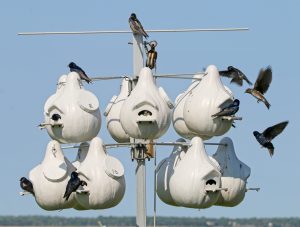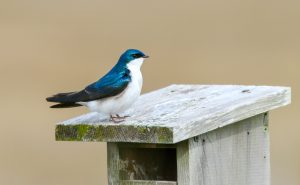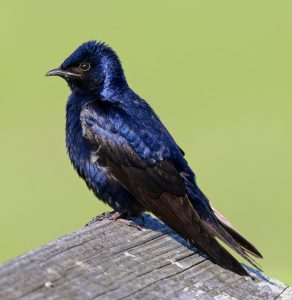by Rae Griffiths, Office Assistant
 Spring migration in Cape May holds many special moments. Whether it be Ospreys returning to nesting platforms; Red Knots scouring the beaches along the Delaware Bay; or colorful warblers traveling north from the tropics, the arrival of migratory birds comes with great anticipation. Every spring, we make special preparations to welcome two aerial acrobats back to the marsh, and this year was no exception.
Spring migration in Cape May holds many special moments. Whether it be Ospreys returning to nesting platforms; Red Knots scouring the beaches along the Delaware Bay; or colorful warblers traveling north from the tropics, the arrival of migratory birds comes with great anticipation. Every spring, we make special preparations to welcome two aerial acrobats back to the marsh, and this year was no exception.
On March 23, we pulled our two “gourd racks” out of the shed and gave the plastic gourds a thorough cleaning before lining each one with a generous layer of fresh, dry pine needles. We then raised them onto a pole about 20 feet off the ground and waited for the first Purple Martin “scouts” – typically the oldest Martins in a population, returning to previous nesting sites. The first scout arrived at The Wetlands Institute on April 3; there are four dozen Martins now, with pairs in each of our nest gourds.
The Purple Martin is the largest North American swallow, and one of many types of birds that nest communally. Like other swallows, they catch insects as their main food source, wheeling about the marsh to grab them out of the air. Unfortunately, mosquitos are not a major part of their diet, but we can thank Martins for keeping the biting fly populations at bay. On the East Coast, Purple Martins nest almost exclusively in human-made nesting structures. Native Americans used hollowed gourds to attract Martins, probably recognizing their value as natural insect control. This, along with a loss of natural nest cavities, likely led to this shift in nesting behavior.
 While Purple Martins nest in colonies, Tree Swallows like to build their nests with a little more elbow room. We maintain nine or 10 Tree Swallow boxes throughout the marsh here, mounted on poles six feet off the ground and set about 30 feet apart. Each pole has a PVC pipe attached below the box to deter predators. This season, we replaced five older, smaller boxes with new ones constructed to the ideal dimensions to attract Tree Swallows.
While Purple Martins nest in colonies, Tree Swallows like to build their nests with a little more elbow room. We maintain nine or 10 Tree Swallow boxes throughout the marsh here, mounted on poles six feet off the ground and set about 30 feet apart. Each pole has a PVC pipe attached below the box to deter predators. This season, we replaced five older, smaller boxes with new ones constructed to the ideal dimensions to attract Tree Swallows.
Once a pair of Tree Swallows selects a nest box, they collect fine dried grass to build a tidy cup nest inside, then line it with feathers before laying four to seven eggs. For most of the year, the Tree Swallows’ diet is predominantly insects, though they supplement with calcium-rich foods like small fish bones, pieces of clamshell, and eggshells. Tree Swallows can also digest bayberries and other small fruits in colder weather when insects are scarce – something no other swallow can manage. This allows them to winter farther north and return to their nesting grounds sooner than any other American swallow.
During the latter half of the 20th century, Tree Swallows and Purple Martins experienced significant declines due to increases in human development and the introduction of invasive species like the European Starling and House Sparrow. Today, dedicated efforts to manage nesting boxes/gourds are helping these species recover. Since 2016, nests at The Wetlands Institute have fledged more than 425 Purple Martin hatchlings and almost 40 Tree Swallows.
 Both Purple Martins and Tree Swallows are known for their mass migrations in the fall, and the marshes along the Maurice River here in South Jersey are considered the largest staging area for Purple Martin migration. In mid-August, hundreds of thousands of these birds gather to fatten up on insects for their long migration to South America. Each evening, the birds fill the sky above the marsh, swooping and diving in what seems like an orchestrated ballet. Then, all at once, they descend into the reeds to take shelter for the night. These collections of Martins are so large they can be seen on weather radar.
Both Purple Martins and Tree Swallows are known for their mass migrations in the fall, and the marshes along the Maurice River here in South Jersey are considered the largest staging area for Purple Martin migration. In mid-August, hundreds of thousands of these birds gather to fatten up on insects for their long migration to South America. Each evening, the birds fill the sky above the marsh, swooping and diving in what seems like an orchestrated ballet. Then, all at once, they descend into the reeds to take shelter for the night. These collections of Martins are so large they can be seen on weather radar.
Tree Swallows also congregate in flocks numbering into the hundreds of thousands to migrate en masse toward their wintering grounds – covering power lines, wires, groves of trees, or wherever else they can find a suitable roost. On Seven Mile Beach, large numbers of Tree Swallows feed in the dunes in September in preparation for their long flights south.
Here at the Institute, Purple Martins and Tree Swallows are busy preparing themselves for the business of raising the next generation. Before long, the skies above the marsh will be filled with young birds taking to the air on newly minted wings, honing their flying skills and building strength for their first epic migratory journey. With a little luck, they will be back next spring – and we will be ready to welcome them home again.
